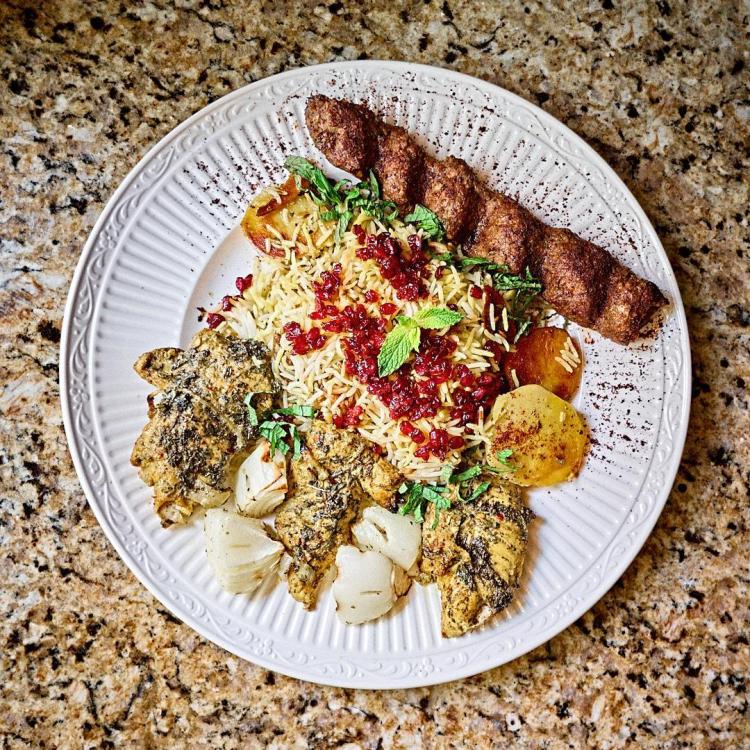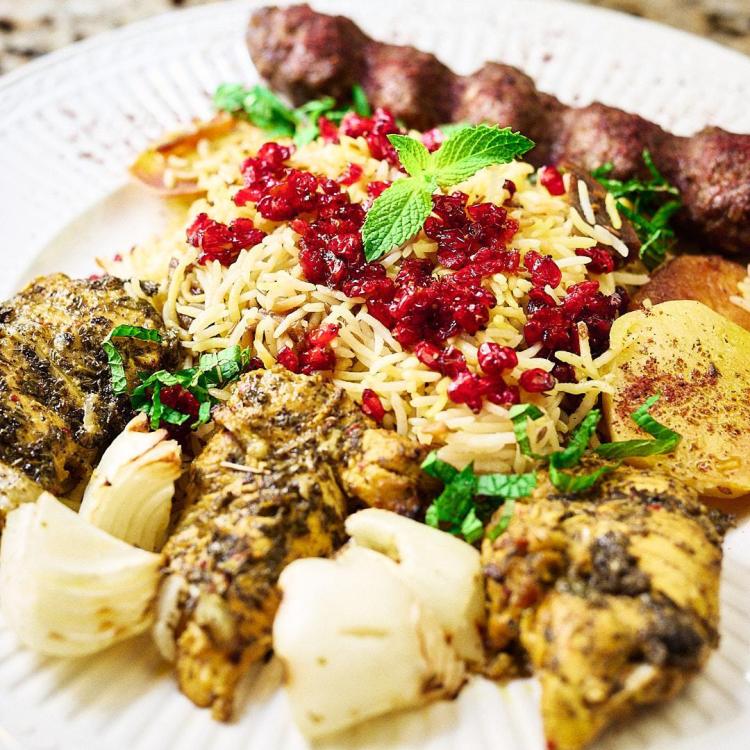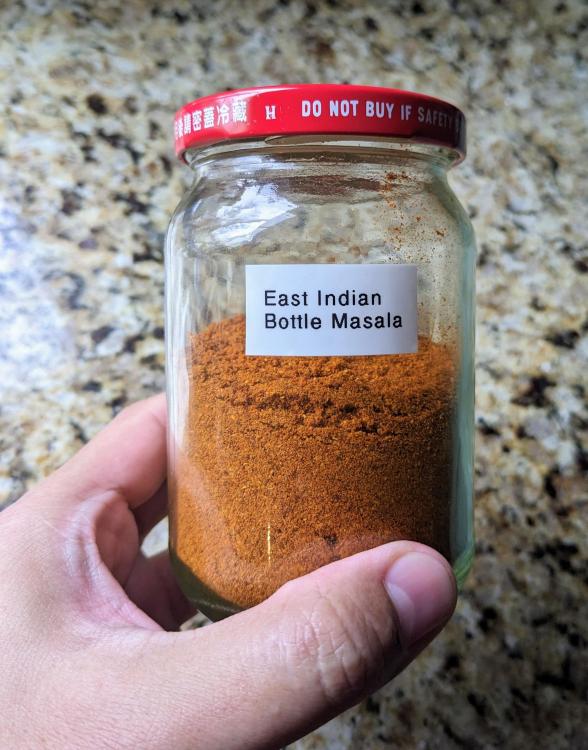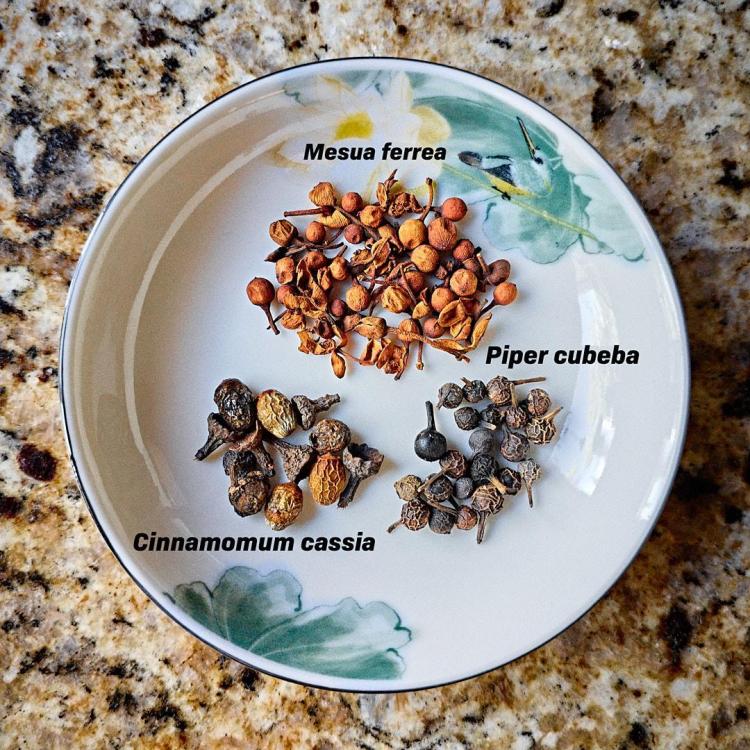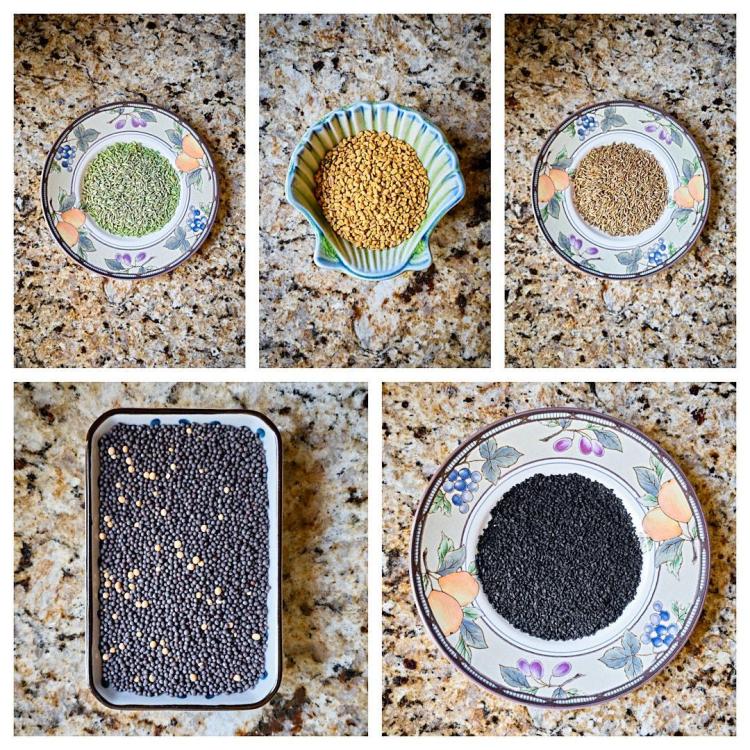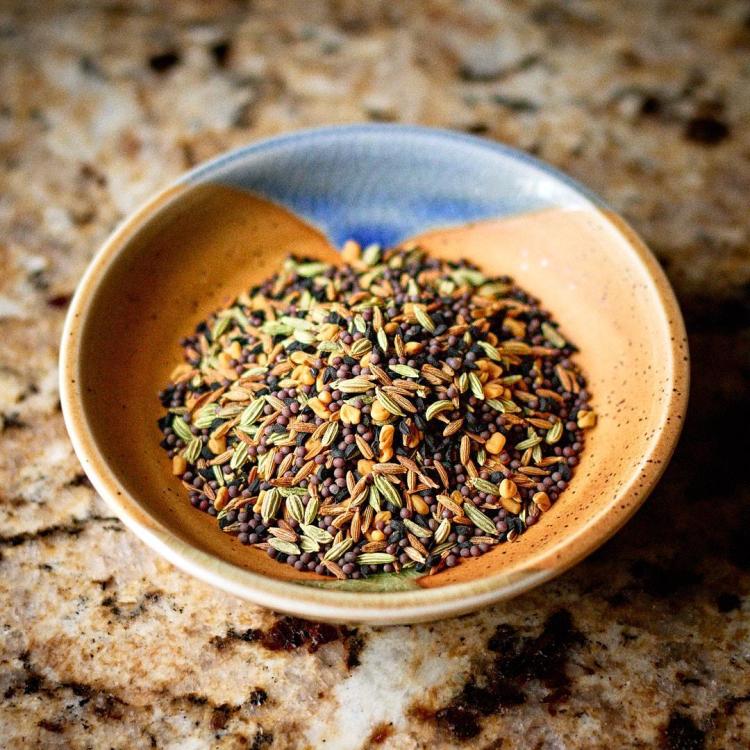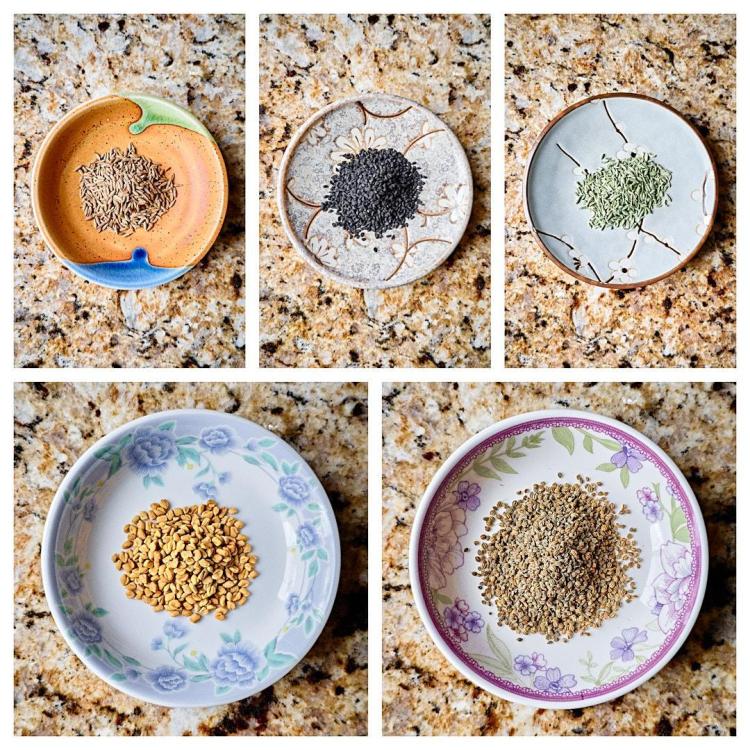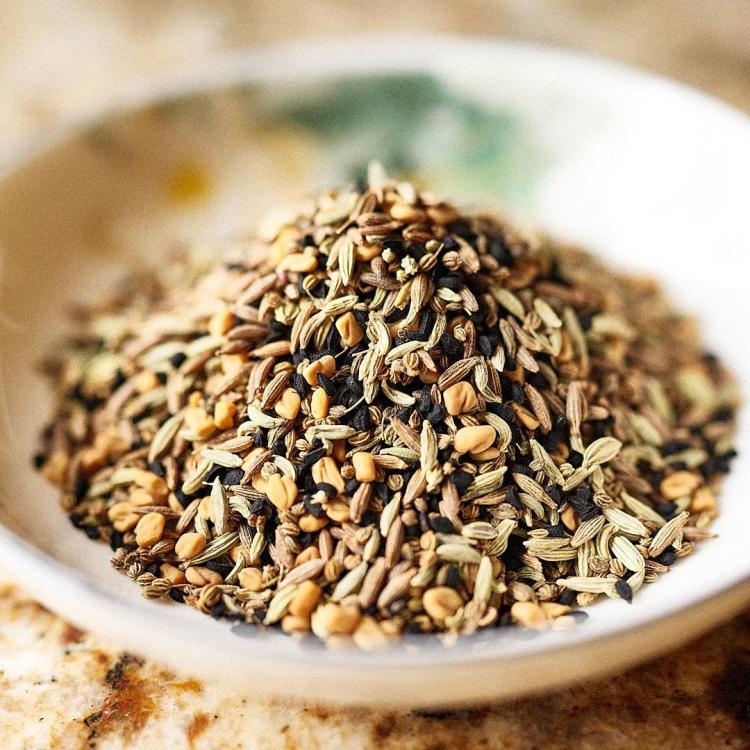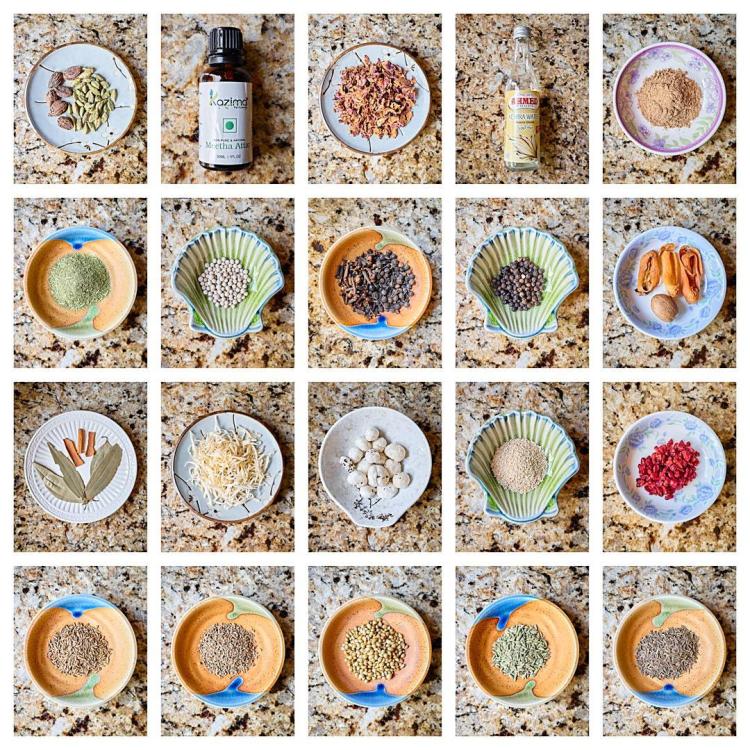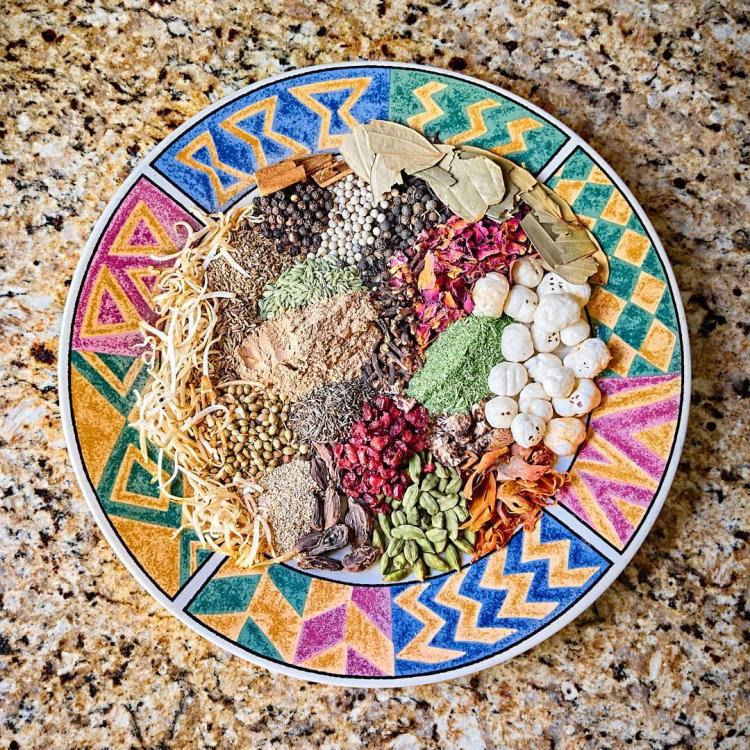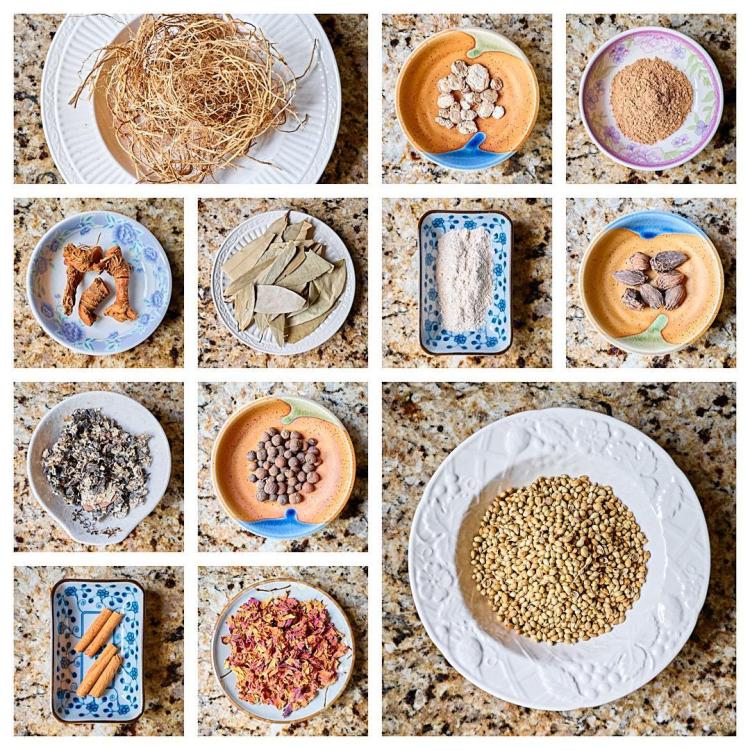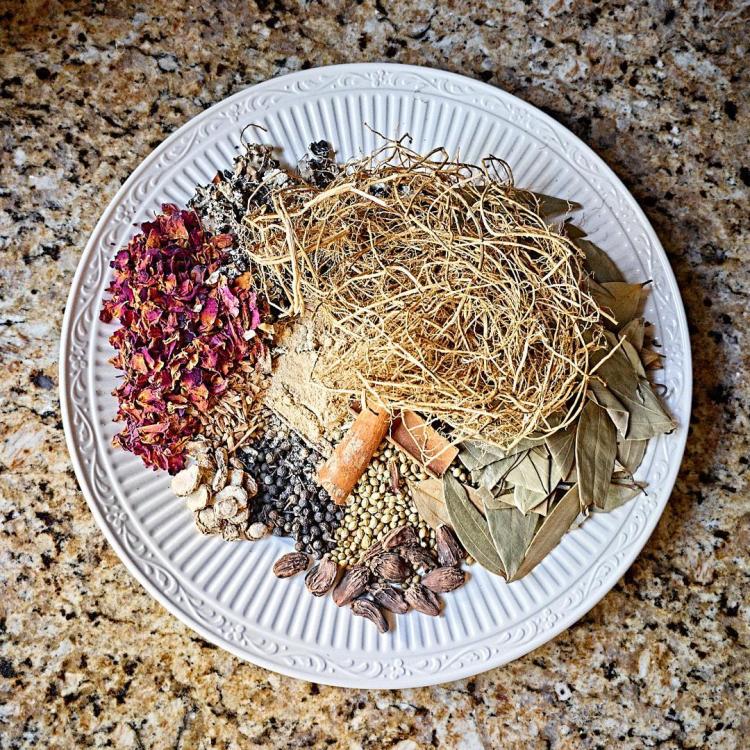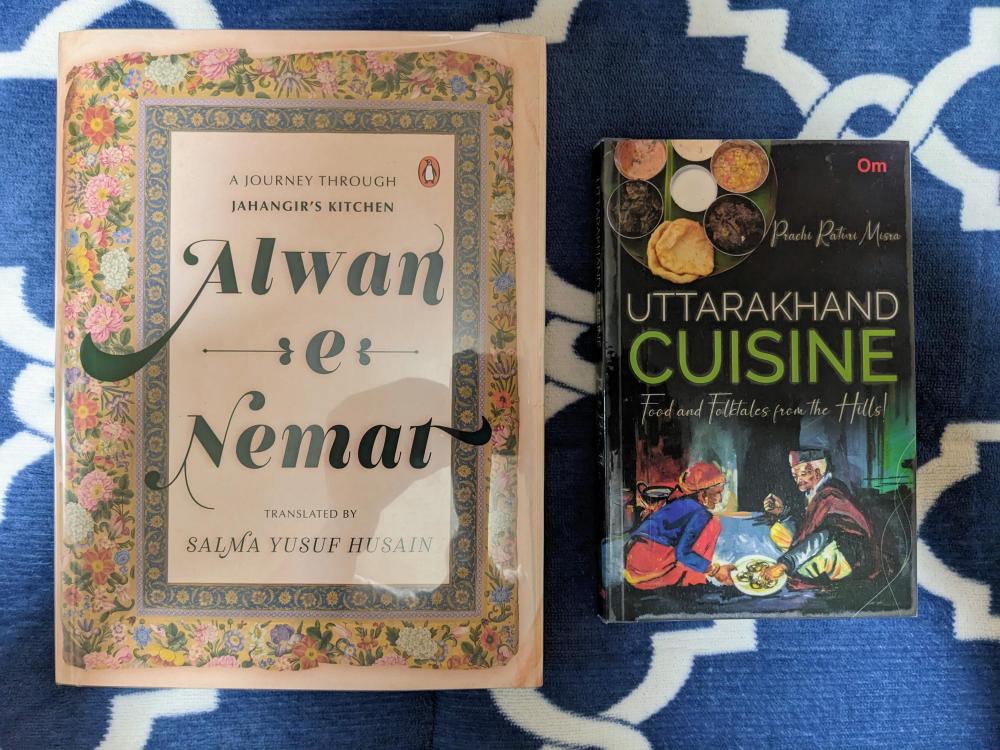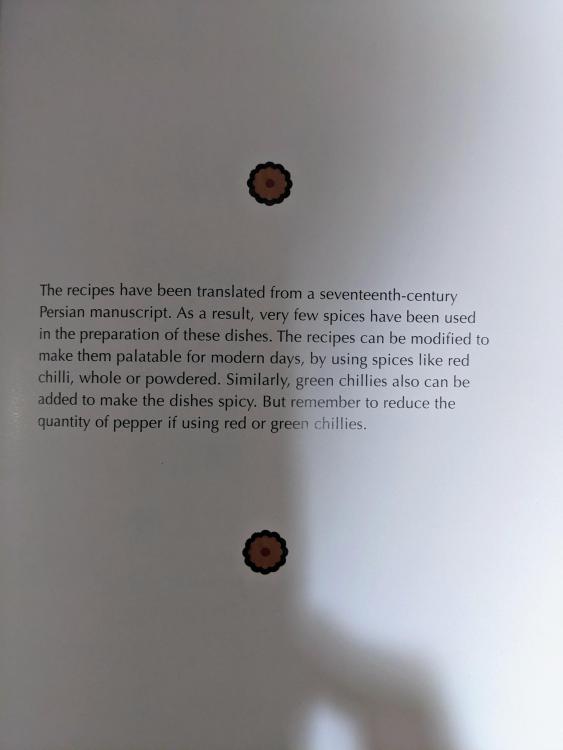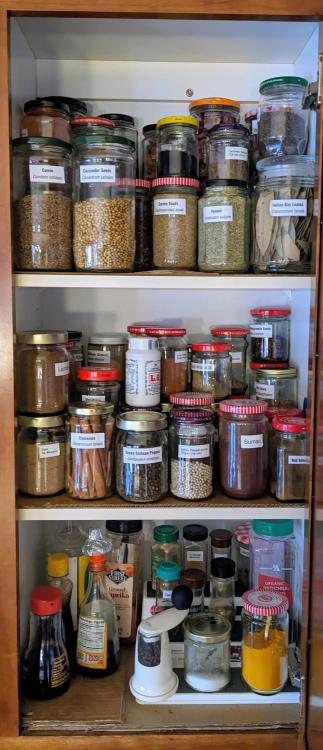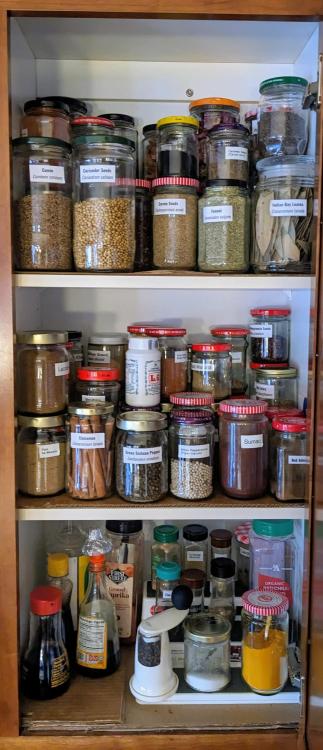
Tan Can Cook
legacy participant-
Posts
97 -
Joined
Content Type
Profiles
Forums
Store
Help Articles
Everything posted by Tan Can Cook
-
Nush-e jan to everyone. Thanks for sharing your wonderful and great tasting dinner. Here's mine: Bandari Kabab-e Soltani with Barberry Pilaf. Bandar is a region in Southern Iran near the Caspian Sea. The recipes comes from the book Cooking in Iran: Regional Recipes and Kitchen Secrets by Najmieh Batmanglij. "Soltani" because it pairs with an additional skewer of Kabab-e Koobideh. This food is part of my regular rotation of my Ashpazi-ye Irani (Iranian Cooking) repertoire.
-
Yup! That looks good enough. In my batch from Essential Marathi Cookbook, I can smell the cubeb peppers. Your version you purchased mentioned of cubeb! Once you receive your supply of Bottle Masala, cook the "Lonvas" recipe on page 249. It was the same recipe Shrimati Kaumudi-ji told me, when I showed her my batch I made. Bon appetit!
-
Greetings from across the pond, sir. Hello @Tempest63. In the USA, we have a super famous and big spice shop called Kalustyan's, based in New York. I don't know, if they ship outside the US. Try that. Another site I know that ships globally is the online store called Silkrute.com. They source ingredients from all over India and ship from their headquarters in Haryana. Takes about 14 days from India the USA. This is how I purchased mawal (Kashmiri dry cockcombs flowers from Kashmir) [Celosia argentea var. cristata] via that Silkrute.com store. Because I cook and eat exclusively regional cuisines from India, Pakistan, Bangladesh, and Iran, these ingredients are used up via regular use in cooking. You also have to keep in mind, that most masale blends' ingredients are called and used for ayurvedic purposes. True, that some of the ingredients in the Bottle Masala impart their floral and fragrance by themselves, when finally mixed, you will mostly be smelling the ground dried red chillies, coriander, turmeric, and cubeb (Piper cubeba).
-
Greetings from across the pond sir. Hi @Tempest63. As far the spices for East Indian Bottle Masala and in your position makes sense. If you read the book, which you and I have, to make the Bottle Masala, this the recipe: 100 gms dried red Rasampatti chillies 75 gms dried red Kashmiri Deghi chillies 75 gms coriander seeds 25 gms (2½ tbsp) turmeric powder 12 gms (2½ tsp) poppy seeds (khus-khus) 12 gms (2½ tsp) sesame seeds (til) 12 gms (3½ tsp) yellow mustard seeds 12 gms (3½ tsp) cumin seeds 12 gms (3½ tsp) black peppercorns 7 gms (1¾ tsp) green cardamoms 7 gms (7 x 1ʺ sticks) cinnamon 7 gms (1½ tbsp) cloves 7 gms wholewheat grains (gehun) 7 gms (1 tsp) split, husked Bengal gram (chana dal) 3.5 gms (1 tsp) royal cumin seeds (shah jeera) 3.5 gms (2 pieces) bay leaves (tej patta) 3.5 gms (4¼ tsp) cassia buds (nagkesar) 3.5 gms sesame flowers (optional) 3.5 gms (3½ blades) mace (javitri) 3.5 gms cubeb pepper (kababchini) 3.5 gms (1 tsp) powdered asafoetida (hing) 1.0 gm (⅓ tsp) fennel seeds (badi saunf) 2.58 gms (½) nutmeg (jaiphal) As for "sesame flowers," even I gave up on finding that. I contacted the author Shrimati Kaumudi-ji at her Instagram. She currently lives in Southern California now. She said it's OK that I omit it. As for finding cassia buds, those are the dried buds of Cinnamomum spp. tree. I sourced it from a Canada spice shop called Pepper Tree and Spice Co. at https://peppertreespice.com/products/cassia-buds-1?variant=44010666426607. Because I exclusively cook foods from India, Pakistan, Bangladesh, and Iran, I use up my spices in a regularly. 90 grams (3.17 oz) of cassia buds (Cinnamomum spp.) cost me a total of 33.00 USD (~26.18 GBP). In transliterated Hindi, they are known as kala nagkesar. Don't confuse kala nagkesar with the other nagkesar, which is Mesua ferrea. In another Marathi cookbook that I have called Pangat, a Feast: Food and Lore from Marathi Kitchens by Saee Koranne-Khandekar, she uses nagkesar (Mesua ferrea) with the English name of cobra saffron / Ceylon ironwood buds. 85 grams (3 oz) of Mesua ferrea cost me total 32.97 USD (~26.15 GBP). What's important is that these ingredients—although adds their floral and fragrance, their presence is masked by the dried red chillies and coriander seeds. If you omit them, the world we know won't implode or anything. I've included some images of how Cinnamomum spp., Mesua ferrea, and Piper cubeba look. I don't know any giant spice shops in the UK, but the biggest and famous one we have in USA is based in NYC. It's famous name: Kalustyans. They charge 3-ounce for 19.99 USD + shipping and taxes, if applicable. https://foodsofnations.com/products/cassia-buds?variant=44375883153628. You can purchase in lesser quantities, but the shipping cost of more or less about the same. In my batch, I've downscaled it to quarter quantity to fit inside the jar. I've placed this in my spice cabinet away from light. Traditionally, they are stored inside recycled dark glass bottles hence the name East Indian Bottle Masala.
-
Bengali (West Bengal and Bangladesh) and Odia Five-Spice Mix Bangla: Panch Phoron Odia: Pancha Phutana Interesting regional variations between the two Five-Spice Mixes. Odia Pancha Phutana from My Odia Kitchen उड़िया पंच फोरन By Tan Can Cook Modified and Adapted from Usha Rani Tripathy A mixture of 5 spices used for tempering curries and other dishes. Ingredients 40.86 g (4 tbsp) black mustard Seeds 23.53 g (3 tbsp) cumin seeds 24.23 g (3 tbsp) nigella seeds 23.61 g (3 tbsp) fennel seeds 24.67 g (2 tbsp) fenugreek seeds Method The above spices are mixed together and stored in an airtight container. At the time of tempering, dry red chilies are mixed to this, either whole or broken with seeds. Bengali Panch Phoron from Pumpkin Flower Fritters and Other Classic Recipes from a Bengali Kitchen बंगाली पंच फोरन By Tan Can Cook Modified and Adapted from Renuka Devi Choudhurani Ingredients 5 g (1½ + ⅛ tsp) cumin seeds 5 g (1½ + ⅛ tsp) nigella seeds 5 g (1⅛ tsp) fenugreek seeds 5 g (1¾ tsp) fennel seeds 5 g (1¾ tsp) wild celery seeds [Trachyspermum roxburghianum / Carum roxburghianum] Method Equal proportions of cumin, nigella, fenugreek, fennel, and radhuni seeds. You may also add red chilli seeds.
-
I find that most spices must be slow roasted and stirring occasionally to "wake them up." Meaning that applying a little heat allows the essential oils inside the spice(s) to maximize their potency. In you situation, try slow roasting your whole coriander seeds and then use any grinder. I use the Magic Bullet with the horizontal blade and not the one with 4 blades (this is for grinding wet mixtures). If you want even finer, you can sieve these through a steel mesh. The ones that were filtered, put them back into your grinder and repeat if necessary. As for cardamom, I use the entirety in my spice blends. If a recipe does call the seeds to be removed (as in: use only the seeds), slightly bruise (crush) with a knife so that you can pull the husk (skin). Do NOT discard the skins! If you have loose black tea, add those green cardamom skins into them. They impart little bits of cardamom smells to the black tea. Certain spices don't grind well, e.g. dried vetiver roots. It is then not only do I grind first using the Magic Bullet, I then have to filter them, further grind in heavy mortar-pestle, and repeat if necessary. Dried galangal (both the greater and lesser) are hard. Grinding and mortar-pestle is a must.
-
As-salaam alaikum everyone. Namaskar(am). Vanakkam. Adaab. Sat sri akal. Greetings from Northern California (USA). My name is Ronald N. Tan, but when cooking, I use my food name of "Tan Can Cook." I would like to start this post and topic for sharing and showcasing the various regional spice blends from India. There is more to spice blends from India than your garam masala, curry powder, etc. I would like to start my post with what I consider to be spice blends that showcases and epitomizes not only India's affluent culinary history, but the collective khansamas and bawarchis culinary creativity. To showcase the complex and layered spice blends, I will share them in the form of mise en place, along with the full recipe of the ingredients. As a masalchi, I am learning and exploring regional spice blends from India, Pakistan, Bangladesh, and Iran. If you have questions or clarifications, please ask in this topic. The recipes are sourced from my personal library of cookbooks sourced direct from India. Lazzat-e-Taam from Dastarkhwan-e Awadh: The Cuisine of Awadh लज़्ज़त-ए-ताम By Tan Can Cook Modified and Adapted from Sangeeta Bhatnagar and R. K. Saxena Ingredients 7 g green cardamom 5 g black cardamom 5 g barberries [Berberis vulgaris] 5 g sandalwood powder, culinary/edible grade [Santalum album] 5 g coriander seeds 5 g lemongrass [Cymbopogon spp.] 5 g cumin seeds 5 g black cumin seeds [Elwendia persica] 5 g cubeb [Piper cubeba] 5 g grated coconut 5 g black pepper 5 g white pepper 5 g poppy seeds 5 g cloves 5 g fox nuts [Euryale ferox] 5 g anise seeds 5 g fennel seeds 3 g mace 1 whole nutmeg 3 g dried rose petals 2 g cinnamon 1 g Indian bay leaves [Cinnamomum tamala] Dried fennel leaves 13 g (1 tbsp) kewra water 11 g (1 tbsp) meetha itr (culinary grade food perfume; I use Deer-brand meetha itr sourced from Kolkata, West Bengal. I don't have any luck finding sellers from Lucknow who would source and ship to the USA) Method Gently roast all dry ingredients over a low flame until fragrant. Remove from heat and grind to a fine powder. Sieve the mixture, then add kewra water and meetha itr. Rub the mixture between your palms and sieve again. If still moist, dry indoors before storing in an airtight jar. Hyderabadi Potli ka Masala from A Princely Legacy Hyderabadi Cuisine हैदराबादी पोटली का मसाला By Tan Can Cook Modified and Adapted from Pratibha Karan Ingredients 50 g coriander seeds 8.75 g dried vetiver roots [Vetiveria zizanioides] 8.75 g Indian bay leaves [Cinnamomum tamala] 8.75 g lesser galangal [Alpinia officinarum] 7.5 g cubeb [Piper cubeba] 7.5 g black stone flowers [Parmotrema perlatum] 6.25 g sandalwood powder, culinary grade [Santalum album] 6.25 g black cardamom 6.25 g whole wheat grains 6.25 g spiked ginger lily roots [Hedychium spicatum] 5 g dried rose petals 3.75 g cinnamon Method Mix these spices and herbs in the given proportions and divide into portions. At the time of use, tie a portion in a muslin cloth or in any thin cloth for insertion in the dish. Use one or more portions as may be required. Store in an airtight jar to prevent insects from getting into the mix. Alternatively, I prefer to ground them into powder and use accordingly in powdered form. Traditionally, they are used as bouquet garni and added into to make broth, flavored water, base, etc.
-
Show us your latest cookbook acquisitions!
Tan Can Cook replied to a topic in Cookbooks & References
Here are my recent purchases. Please ignore the specular highlights as they are from the Brodart archival mylar that I covered of Alwan-E-Nemat: A Journey Through Jahangir's Kitchen (October 2024) and Demco adhesive for the paperback book on Pahadi cuisine from Uttarakhand state in India called Uttarakhand Cuisine: Food and Folktales from the Hills! I got lucky and found a reputable independent bookseller on Biblio importing authentic books (priced fairly and competitively) from India. I've already read through the Alwan-e-Nemat book, since it is right up my alley of being immensely fascinated by Mughlai and Nizami cuisines of India. Brief trivia. Most of everyone know about the famous "Taj Mahal" of India. It was built by Shah Jahan. He was the 5th Mughal emperor. His father Emperor Jahangir is the 4th Mughal emperor and the book is a culinary time travel into 17th century "Mughal Hindustan" his kitchens based on Persian manuscripts. Google Books has some previews of the introduction sections, which might be interesting to some history and cultural perspectives. https://www.google.com/books/edition/Alwan_E_Nemat/zzgxEQAAQBAJ?hl=en&gbpv=0. The author—Shrimati Salma Husain ji—wrote The Mughal Feast: Recipes from the Kitchen of Emperor Shah Jahan (A Transcreation of Nuskha-e-Shahjahani) in 2021. Based on how I positioned the books, they are at the extreme polar opposites in terms of ingredients, taste, and flavor profiles. You have the time travel back to Mughal-era India, when India was on its apex of wealth and affluence. Next to it, the cuisines from the Pahahi people of Uttarakhand, who live along the Himalayan Hills in not to friendly environments to grow food and ingredients. -
Here is a portion of my spices. I reuse glass jars and manually label my spices in their English names on the first line and their Latin (botanical) names on the second line. Before, the labels were in Hindi, because I was learning the Hindi names for all of my spices in my collection. Now that I know all their Hindi names, it's back to English and Latin names. I have much more spices in other sections of my kitchen. My cooking is specialized to Indian, Pakistani, Bangladeshi, and Iranian. All my spices are expansive and stocked so that I could create any regional bespoke spice blends at any given time.
-
You win! 🙂 I wish my kitchen has this large-sized cabinet. All my spices will probably fill this entirety.
-
Books on Awadh, Rampur, Hyderabad, Bengali (West Bengal and Bangladesh), and Kashmiri Wazwan books are my favorites. Mainly because my cooking interests are following the Mughlai and Mughlai-adjacent cooking styles. Dastarkhwan-e Awadh: The Cuisine of Awadh is my first-ever cookery book that I saved up from cooking tips. I remember it cost me close to 45 USD for the paperback version bought in 2022. Now it seems that book is out of print and the hardcover (used) cost around 400 USD?!?! Long story short, that book has been on my list to buy, because it contains a recipe for Lazzat-e-Taam, a super masala mix comprising of around 25 ingredients of spices and herbs. This thread here on eGullet mentions this spice recipe or people talking about where to find mentioned ingredients. A Princely Legacy: Hyderabadi Cuisine is another book that is now out of print and people are selling for hundreds of dollars used! This book boasts the rich and affluent culinary history of the former princely state of Hyderabad. Today, Hyderabad is the capital of Telangana State, India. I like this book, because it contains the recipe for Hyderabadi Potli ka Masala. It basically look and smells like potpourri. It makes you feel like you're cooking with food perfume and imparting strong, aromatic floral sensory elations to the dishes cooked. The fun part is cooking recipes from all those books I have. I rotate my books. Spice blends are also made in small batches, because a "garam masala" recipe for cooking foods in Delhi will be different "garam masala" for foods cooked in the book for Sindhi (Pakistani) cuisine.
-
I don't have any times, other than to share a portion of my expansive spice collection. Because I only cook cuisines of regional India, Pakistan, Bangladesh, and Iran, my spices are specialized for those cuisines. I recycle jars and glasses, which were cleaned well, washed inside with high-temperature dish water with sanitation option. I manually made labels: common English names and underneath its botanical (Latin) names. Prior, the labels were in Hindi to help learn Hindi names for my spices. Now that I've learnt their Hindi names, they now appear in English with Latin names. Because I am the one created and organized these jars, I know exactly where certain ingredient(s) are located. On the top most shelf are regional specific spices and herbs. You'll find dried vetiver roots, lesser galangal, long pepper, Kashmiri dried cockscomb flowers, dry rose petals, black stone flowers, etc. In that regard, even though my spices may not look "organized or aesthetically pleasing to the eyes," I can find any ingredient(s) I want and need at any given time.
-
Show us your latest cookbook acquisitions!
Tan Can Cook replied to a topic in Cookbooks & References
When it comes to regional Indian cuisine, my focus is Mughlai and Deccani cuisines and my studies and interests follows the Mughal culinary path and its adjacents. I have experiences cooking Awadhi/Rampuri and Hyderabadi foods. Because I also know Persian cuisine, I see immense Persian influences on Mughlai foods. -
Show us your latest cookbook acquisitions!
Tan Can Cook replied to a topic in Cookbooks & References
I am a huge fan of South Asian (Desi) regional cuisine spanning present day India, Pakistan, Bangladesh, and Iran. It's great to run into another foodie who is into regional Desi Khana. Namaskar from across the pond in California (USA). -
For learning classical and traditional Bangla Ranna, I use the following books that I import purchased. Shipping was a little more from Bangladesh to the USA. The fees were justified by the recipes and techniques from the books. Osman, Shawkat. Bangladeshi Cuisine. Kolkata, West Bengal, India: Mapin Publishing, 2008. Zaman, Niaz. Bosha Bhat to Biryani: The Legacy of Bangladeshi Cuisine. Dhaka, Bangladesh: University Press Limited, 2012. I purchased Professor Zaman's book direct from the publisher at https://uplbooks.com/shop/9789845060332-bosha-bhat-to-biryani-the-legacy-of-bangladeshi-cuisine-8327#attr=13751. I was informed by Mahrukh Mohiuddin, Managing Director at University Press Limited (UPL) that they ship worldwide. My final fee for Prof. Zaman's book came out to be 56.84 USD. Chef and Bangladeshi TV host and presenter Shawkat Osman—not to be confused with another famous author of the same name—book called Bangladeshi Cuisine was purchased from my goto independent seller going as "Table Top Art" on the Amazon USA Marketplace. They specialize in importing authentic cookbooks from India, Pakistan, and Bangladesh. They didn't stock Prof Zaman's book, that's why I decided to acquire direct from the publisher. If you prefer not to use Amazon, my trusted bookseller also goes by the name "Cold Books" on Biblio and "Books Puddle" on AbeBooks. They are all the same, happen to have different names on various selling platforms.
-
Namaskar. Adaab from Northern California (USA). I wanted to share with you my list of regional South Asian (Desi) cookbooks I've been saving up and acquiring. Some as direct purchases from Pakistan, India, and Bangladesh. This list is my current and formatted in Chicago Manual of Style bibliographic. Regional Indian, Pakistani, Bangladeshi, and Provincial Iranian (Persian) Cookbooks I guess I got lucky and found a professional independent bookseller going as "Table Top Art" on Amazon Marketplace and "Cold Books" on Biblio. They are one and the same, using difference names on various platforms. They are also "Books Puddle" on AbeBooks. Abdulla, Ummi. A Kitchen Full of Stories: Mappila Kitchen Treasures. Self-published, Bengaluru, Karnataka: Tholasi Prints India, 2018. Ali, Meera. Dining with the Nawabs. India: Lustre Press, Roli Books, 2017. Alikhani, Nasim, and Theresa Gambacorta. Sofreh: A Contemporary Approach to Classic Persian Cuisine. New York, NY: Alfred A. Knopf, 2023. Batmanglij, Najmieh. Food of Life: Ancient Persian and Modern Iranian Cooking and Ceremonies. 4th ed. Chevy Chase, MD: Mage Publishers, 2021. Batmanglij, Najmieh. Cooking in Iran: Regional Recipes & Kitchen Secrets. 2nd Updated ed. Chevy Chase, MD: Mage Publishers, 2022. Bhatnagar, Sangeeta, and R. K. Saxena. Dastarkhwan-e-Awadh: The Cuisine of Awadh. Noida, Uttar Pradesh, India: HarperCollins Publishers, 2015. Choudhurani, Renuka Debi. Pumpkin Flower Fritters and Other Classic Recipes From a Bengali Kitchen. Ranikhet, Uttarakhand, India: Orient Blackswan, 2011. Das, Jyoti. Ambrosia from the Assamese Kitchen. Daryaganj, New Delhi, India: Rupa & Co., 2008. Das, Jyoti. Essence of North East. New Delhi, India: National Book Trust, 2019. Das Gupta, Minakshie, Bunny Gupta, and Jaya Chaliha. The Calcutta Cookbook: A Treasury of Recipes From Pavement to Palace. Gurugram, Haryana, India: Penguin Books, 1995. Husain, Salma Yusuf. The Mughal Feast : Recipes From The Kitchen Of Emperor Shah Jahan. New Delhi, India: Lustre Press, Roli Books, 2021. Husain, Salma Yusuf. Flavours of Avadh Journey from the Royal Banquet to the Corner Kitchen. New Delhi, India: Niyogi Books, 2022. Husain, Salma. Alwan-E-Nemat: A Journey Through Jahangir's Kitchen. India: Penguin Random House India Private Limited, 2024. Hussain, Jafar Mirza. The Classic Cuisine of Lucknow: A Food Memoir. Translated by Sufia Kidwai. Lucknow, Uttar Pradesh, India: Sanatkada Publications, 2016. Kalra, J. Inder Singh, and Pushpesh Pant. Classic Cooking of Punjab. New Delhi, India: Allied Publishers, 2004. Kalra, J. Inder Singh. Classic Cooking of Rajasthan. New Delhi, India: Allied Publishers, 2006. Kannampilly, Vijayan. The Essential Kerala Cookbook. New Delhi, India: Penguin Books, 2003. Kapoor, Sanjeev, and Harpal Singh Sokhi. Royal Hyderabadi Cooking. Mumbai, Maharashtra, India: Popular Prakashan, 2009. Karan, Pratibha. A Princely Legacy: Hyderabadi Cuisine. Gurugram, Haryana: HarperCollins Publishers India, 1998. Khan, Noor, and Sufia Kidwai. Lucknowi Bawarchi Khane: Recipes from Lucknow Homes. Lucknow, Uttar Pradesh, India: Sanatkada Publications, 2022. Khan, Tarana Husain. Degh to Dastarkhwan: Qissas and Recipes from Rampur Cuisine. Gurugram, Haryana, India: Penguin Books, 2023. Khatau, Asha. The Best of Epicure’s Gujarati Cuisine. Mumbai: Popular Prakashan, 2012. Koranne-Khandekar, Saee. Pangat, a Feast: Food and Lore from Marathi Kitchens. Gurugram, Haryana: Hachette India, 2019. Latif, Bilkees I. The Essential Andhra Cookbook with Hyderabadi Specialities. New Delhi, India: Penguin Books, 1999. Manekshaw, Bhicoo J. Parsi Food and Customs: The Essential Parsi Cookbook. Gurugram, Haryana, India: Penguin Books, 1996. Marathé, Kaumudi. The Essential Marathi Cookbook. New Delhi, India: Penguin Books, 2009. Mehendale, Aditya. Rare Gems: A Non-Vegetarian Gourmet Collection from Maharashtra. India: Om Books International, 2015. Menezes, Maria Teresa. The Essential Goa Cookbook. Gurugram, Haryana, India: Penguin Books, 2000. Misra, Prachi Raturi. Uttarakhand Cuisine: Food and Folktales From The Hills! India: Om Books International, 2024. Murugappan, Meyyammai, and Visalakshi Ramaswamy. The Chettinad Cookbook. Chennai, Tamil Nadu, India: Meyyammai Murugappan & Visalakshi Ramaswamy, 2014. Nandan, Anjani. Beyond Litti Chokha: Flavours of Purvanchal and Mithilanchal. Siliguri, West Bengal, India: Inspiria Knowledge Campus, 2024. Narain, Priti. The Essential Delhi Cookbook. Gurugram, Haryana, India: Penguin Books, 2000. Osman, Shawkat. Bangladeshi Cuisine. Kolkata, West Bengal, India: Mapin Publishing, 2008. Prasada, Neha. Dining with the Maharajas: A Thousand Years of Culinary Tradition. India: Lustre Press, 2013. Radhakrishna, Sabita. Annapurni: Heritage Cuisine from Tamil Nadu. New Delhi: Roli Books, 2015. Radhakrishna, Sabita. Paachakam: Heritage Cuisine of Kerala. New Delhi: Roli Books, 2022. Reejhsinghani, Aroona. The Essential Sindhi Cookbook. Gurugram, Haryana, India: Penguin Books, 2004. Shaikh, Razique Hosain. Ama Rajya Ama Khadya: The Traditional Food Lab of Odisha. Bhubaneswar, Odisha, India: Walnut Publication, 2022. Singh, Digvijaya. Cooking Delights of the Maharajas: Exotic Dishes from the Princely House of Sailana. 14th ed. Mumbai, Maharashtra, India: Vakils, Feffer & Simons, 2022. Tripathy, Usha Rani. My Odia Kitchen. Bhubaneswar, Odisha, India: Amadeus Press, 2016. Waza, Sharief, Shafi Waza, Rafiq Waza, and Rocky Mohan. Wazwaan: Traditional Kashmiri Cuisine. New Delhi, India: Roli Books, 2020. Zaman, Niaz. Bosha Bhat to Biryani: The Legacy of Bangladeshi Cuisine. Dhaka, Bangladesh: University Press Limited, 2012.

